Arm Announces Neoverse V1, N2 Platforms & CPUs, CMN-700 Mesh: More Performance, More Cores, More Flexibility
by Andrei Frumusanu on April 27, 2021 9:00 AM EST- Posted in
- CPUs
- Arm
- Servers
- Infrastructure
- Neoverse N1
- Neoverse V1
- Neoverse N2
- CMN-700
The Neoverse V1 Microarchitecture: X1 with SVE?
Starting off with the new Neoverse V1, the design is both of a familiar origin, but also has a few distinct features that we see for the first time ever in an Arm CPU. As noted in the introduction, the V1 was designed at the same time as the Cortex-X1 by the same team at Arm’s Austin design centre, with large similarities between the two microarchitectures when it comes to the block structures.
What’s notable about the V1, in comparison to the X1 and of course the predecessor N1, is the fact that this is now an SVE capable processor, with two native 256b SIMD pipelines, and also introducing server-only features such as coherent L1I caches, bFloat16 execution capabilities, and a slew of distinct characteristics we’ll cover in just a bit.
The architectural features of the Neoverse V1 are probably the most complicated in terms of describing – essentially, it’s a v8.4 baseline architecture which also pulls v8.5 and v8.6 features in for the HPC oriented workloads the design is aimed for. Given that we talked about Armv9 only a month ago, this may seem a bit odd, but again we have to remember that the V1 has been designed some time ago and that customers have had the IP for quite a while now, taping in or having already taped out V1 processors.
The big promise of the V1 is its extremely large performance jump over the N1, coming in at an IPC increase of +50%. This sounds large, and it is, but it’s also not all that surprising given that the microarchitecture essentially is 2 microarchitecture design generations newer than the N1, even through from a infrastructure product standpoint it’s only one generation newer.
From a high-level pipeline standpoint and microarchitecture view, the Neoverse V1 is very similar to the X1. It’s still an extremely short pipeline design that has a minimum of 11 stages, with Arm putting a lot of focus on this aspect of their microarchitectures to reduce branch misprediction penalties as much as possible. This aspect of the microarchitecture has remained relatively static over the last few iterations of the Austin family of designs starting with the A76, so Arm notes that the frequency capabilities of the V1 is essentially unchanged when compared to the N1, with performance boosts coming solely from increased IPC.
The V1 sees a lot of the front-end improvements we’ve seen with the Cortex-A77 and Cortex-X1 generations, which saw larger front-end branch improvements such as a doubled up bandwidth for the decoupled fetch unit, much larger L2 BTB to up to 8K entries, and a rearranging and resizing of the lower level BTBs, with the L0 (nanoBTB) growing to 96 entries, and the L1 BTB (microBTB) no longer being present when compared to the Neoverse N1.
The V1 one when compared to the N1 also adds in new structures that hadn’t been present in the design, such as the introduction of a macro-Op cache of up to 3K decoded instructions. The dispatch bandwidth from the Mop cache is 8-wide, while the actual instruction decoder this generation is 5-wide, much the same as on the X1.
The out-of-order windows size is essentially doubled when compared to the Neoverse N1, with the ROB growing to 256 entries. This is actually a tad larger than what Arm was willing to disclose for the Cortex-X1 where the company had only talked about a “OoO window size of 224”, so in this regard this seems to be a differentiation to what we’ve seen in the X1.
On the back-end integer execution pipelines, the design also pulls in the many changes we’ve seen with the A77 generations, which amongst others include a doubling of the branch execution ports, and a new complex ALU capable of simple instructions such as additions as well as more complex operations such as multiplications and divisions.
Obviously enough, the new SIMD pipelines are very different on the V1 given that this is Arm’s first ever SVE capable microarchitecture. The design has two pipelines with seemingly two dedicated schedulers, with native capability for 256b wide SVE vectors. The design is fully backwards compatible for 128b NEON/FP operations in which the pipelines then essentially act as 4x128b units, meaning it has the same execution width as the X1 in that regard.
Compared to the N1, the new design also supports new bFloat16 and Int8 data formats which greatly increase the AI and ML inferencing performance capabilities of the core.
On the memory subsystem side, we also see the increased unit count found on the Cortex-X1, including 2 load/store units and one load unit, meaning the core is capable of up to 3 loads per cycle and 2 stores per cycle maximum. SVE vector bandwidth is 2x32B per cycle for loads, and 32B per cycle for stores.
The core naturally includes the data parallelism improvements seen on the X1 in order to increase MLP (Memory-level parallelism) capabilities.
The L2 cache has also adopted a similar design to that of the X1, which is now 1 cycle faster at the same 1MB size, and has double the number of banks in order for increased access parallelism.
Arm here discloses a quite large reduction in the system level latency for the V1. Besides structural improvements, new generation prefetchers are a big part of this, such as the introduction of a new type of temporal prefetcher which is able to latch onto arbitrary access patterns over time and recognise subsequent iterations of the same pattern, and pull the data in.
Arm discloses that the core has new dynamic prefetching behaviour that plays a major role in reducing L2 to interconnect traffic, which is a critical metric in large core count systems where every byte of bandwidth needs to be of actual use and cannot be wasted for wrongly speculated prefetching.


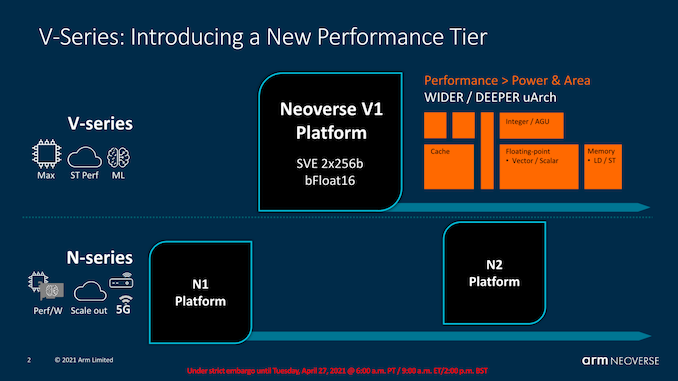
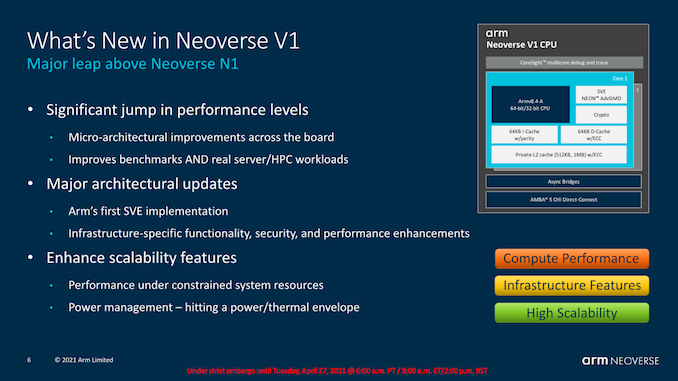
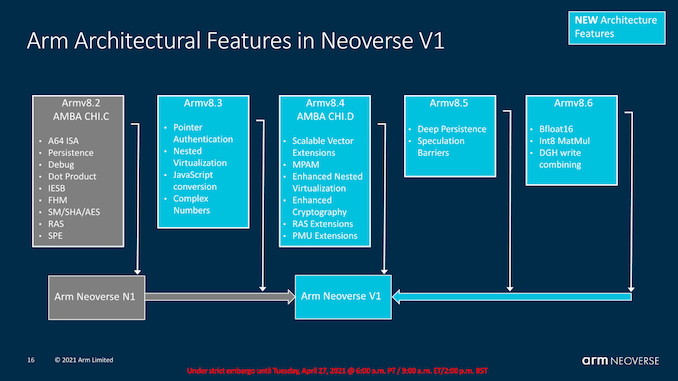
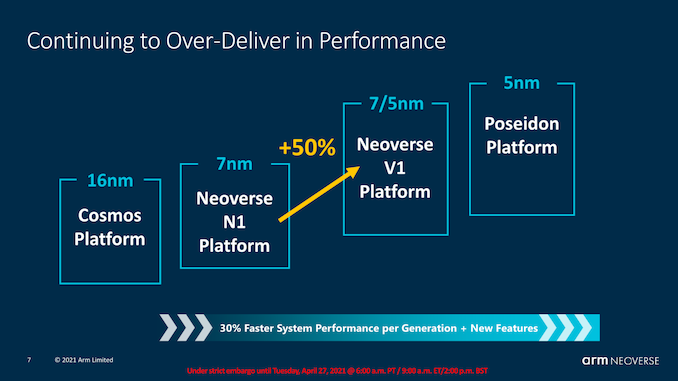
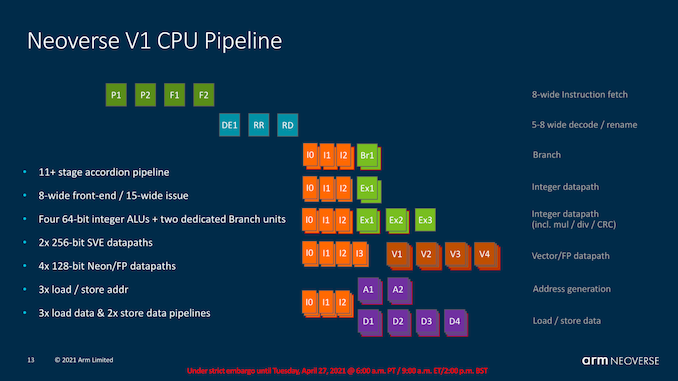

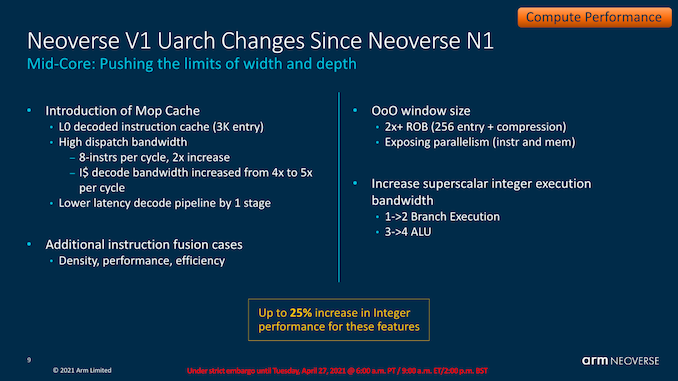


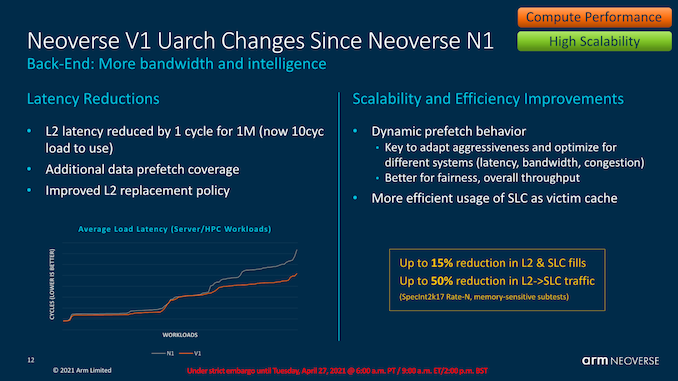








95 Comments
View All Comments
GeoffreyA - Friday, April 30, 2021 - link
"This is in comparison to x86 which seems to live in (probably justified) terror that any change they make, no matter how low level"P6, Netburst, Sandy Bridge, and Bulldozer seem like pretty big changes.
name99 - Friday, April 30, 2021 - link
(a) Sandy Bridge was the last such.(b) Look at the relative spacing (in time) for the two cases.
Look, I'm not interested in "x86 vs ARM. FIGHT!!!"
I'm simply pointing out various patterns I've noted that strike me as interesting and significant. If other people have similar such patterns to point out -- interesting and non-obvious aspects of new x86 micro-architectures, or patterns in how those micro-architectures have evolved over the past few years, they should add a comment.
But to this outsider the micro-architectures look stagnant -- utterly so in the case of Intel, mostly so in the case of AMD. In particular slight scaling up of an existing micro-architectures because a new process is more dense is not interesting! What is interesting is a new way of conceptualizing the problem that allows for a step change in the micro-architecture; and that is what I am not seeing on the x86 side.
I do see it in IBM (though for purposes that are, to me, uninteresting, both for POWER and for z/)
I do see it in ARM Ltd.
mode_13h - Friday, April 30, 2021 - link
> What is interesting is a new way of conceptualizing the problem that allows for a step change in the micro-architectureYes, but I think that largely depends on the ISA. And there, ARM has indeed been rather stagnant. Besides SVE and their new security features, most of their ISA changes have been tweaking around the margins. Not a fundamental rethink, or anything close to it.
What we need is more willingness to rethink the SW/HW divide and look at what more software can do to make hardware more efficient. Whenever I say this, people immediately seem to think I mean doing a VLIW-like approach, but that's too extreme for most workloads. You just have to look at an energy breakdown of a modern CPU and think creatively about where compilers could make the hardware's job a little bit easier or simpler, for the same or better result.
You can also flip it around, and ask where the primitives CPUs provide don't quite match up with what software is trying to do. I think TSX/HLE stands as an interesting example of that, and probably one where Intel doesn't get enough credit (granted, partly due to their own missteps).
name99 - Friday, April 30, 2021 - link
Architecture and micro-architecture are two different things.You want to fantasize about different architectures, be my guest. But I'm interested in MICRO-ARCHITECTURE and that was the content of my comments.
mode_13h - Saturday, May 1, 2021 - link
> Architecture and micro-architecture are two different things.The principle manifestation of the HW/SW divide is the ISA. That's why I talk about it rather than "architecture", which is a word that can mean different things to different people and in different contexts.
> You want to fantasize about different architectures, be my guest.
It's about as on-topic here as ever, given that we've gotten our most detailed look at ARMv9, yet. And performance + efficiency numbers!
> But I'm interested in MICRO-ARCHITECTURE and that was the content of my comments.
There's only so much you can do, within the constraints of an ISA. ARM had a chance to think really big, but they chose to play it safe and be very incremental. That could turn out to be a very costly mistake, for them and some of their licensees.
I just want what I think we all want, which is another decade of progress in performance and efficiency like the last one. So far, I'm not very hopeful. I guess we need to really hit the wall, before people are ready to get serious about embracing options to push it back, a bit further.